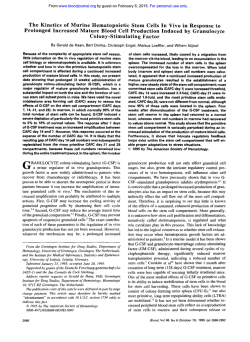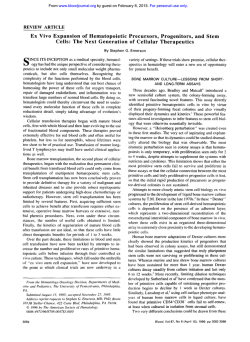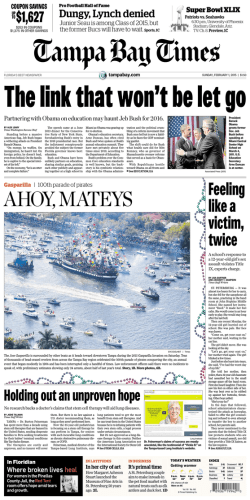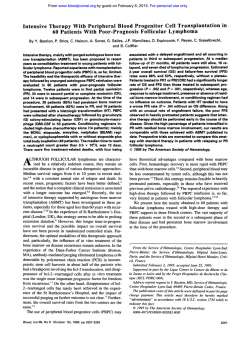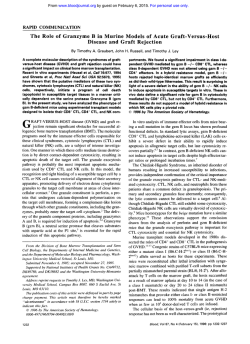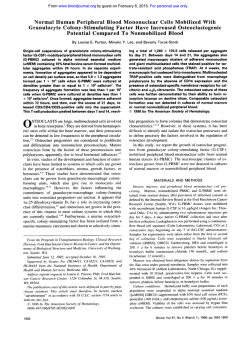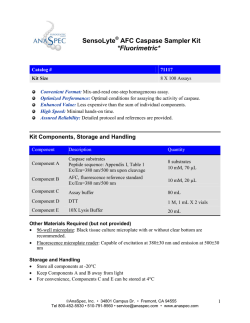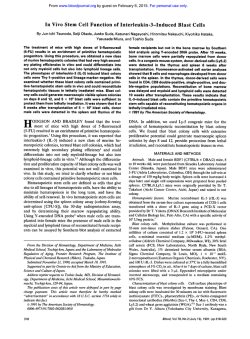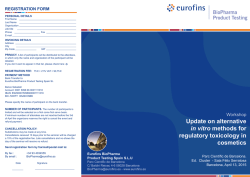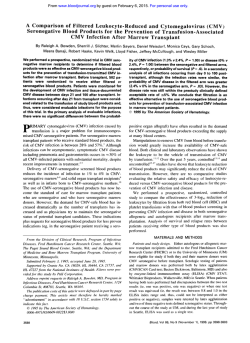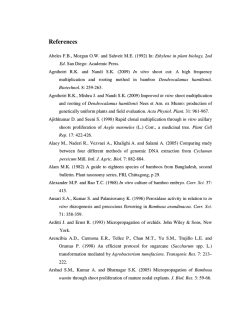
IN VITRO ASSAYS FOR PRIMITIVE HEMATOPOIETIC CELLS For
From www.bloodjournal.org by guest on February 6, 2015. For personal use only. 834 CORRESPONDENCE IN VITRO ASSAYS FOR PRIMITIVE HEMATOPOIETIC CELLS To the Editor In their recent report in Blood, Weilbaecher et al’ presented data indicating that limiting-dilution analysis (LDA) for long-term reconstitution of long-term bone marrow cultures (LTBMC) can serve as a quantitative measure of hematopoietic stem cell (HSC) activity. Aside from their unfortunate denotation of ‘long-term culture initiating cells’ with the nondescriptive term ‘CFU-Dex,’we are pleased that Weilbaecher et a1 used our LDA assaf’ in their laboratory, including the replating studies: and supported our earlier conclusions, that the onset and longevity of clonal expansion in LTBMC is a function of HSC primitiveness.24 We would From www.bloodjournal.org by guest on February 6, 2015. For personal use only. CORRESPONDENCE have enjoyed it if these investigators had properly acknowledged our time-consuming efforts to establish an in vitro assay, which allows statistically sound frequency analysis of CFU-S day 12 and more primitive stem cells with marrow repopulating ability, MRA? Instead, the original study’ was used as a trivial citation in their Material and Methods section. In the Discussion the investigators admitted that we also described “an LDA assay” using microLTBMC, but unfairly discredited it by stating that specificity and overall activity of stem cells during our separation protocols were not determined. We feel that this critique does not reduce the originality and impact of our LDA assay in showing frequency correlations of cobblestone area-forming cells (CAFC) and in vivo defined HSC subsets. In addition to the doubts we have with regard to the originalityof their study, we have various scientific reservations over the significance and presentation of the data in the report of Weilbaecher et al. A minor point is their claim that the CFU-Dex “colonies consist primarily of maturing myeloid and erythroid cells,” which is fully contradicted by their results. More serious is the wide range of CFU-Dex frequencies per cell fraction, which sharply contrasts with the high reproducibility of the CAFC assay.*Inthe scanning of wells for “proliferating colonies consisting of more than 30 cells,” proliferation is not determined by any means. The investigators have not observed that the ‘typical Dexter colony’ as they score it may persist for up to 2 weeks without any proliferation occurring, an event largely similar to that occurring in semisolid colony assays. Due to this, frequency analysis using CFU-Dex will consistently overestimate the number of proliferating clones as soon as the first clones have matured, which depends on the culture time and the relative proportion of HSC with transient and long-lived clonal properties in a particular fraction. In our assay’” we used a primitive and proliferation-dependent LDA endpoint, ie, wells were scanned every 1 to 3 days and scored positive if containing at least one cobblestone area, the presence of which we reported to be strictly associated with replatable CFU-G/M. To establish a relationship between CAFC and CFU-Dex in our laboratory we have scored both parameters in an LDA assay using unfractionated and sorted bone marrow cells. The data that are presented in Table 1 indicate that CFU-Dex frequencies are 1.5 to 4-fold higher than CAFC frequencies after 1 week of culture, and therefore are less suitable as a quantitative in vitro indicator of the CFU-S day-12 incidence and marrow repopulating ability of a graft as demonstrated by a regression study? Table 1 also shows that stem cells with the potential for long-term hematopoietic engraftment of a stromal layer in vitro do not necessarily display high CFU-S day-12 activity as is suggested by the data of Weilbaecher et a]. The report of Weilbaecher et a1 may impress the unprepared reader with a 1,300-fold enrichment for Thy’”Lin-Sca-l+cells; however, only one extremely low frequency for CFU-Dex day 28 in unfractionated marrow is used throughout that was derived from one experiment (ie, the 1in 110,OOO in their Tables 2,3, and Fig 3). The investigators admit that “not enough colonies were found in other experimentsto calculate the response frequencies” at day 28. The enrichment is further expanded by their best separation on ThpLin-Sca-1’ cells, since this frequency (as high as 1in 80) even falls outside the range that the investigators give for this cell population (1 in 85 to 230). Furthermore, in their discussion the investigators state that establishing assay systems that can be used to quantify HSC requires information about the proportion of HSC and non-HSC precursors responding in the assay. However, they present semiquantitative data based on earlier reports, and even a report under review, that do not allow correlations with the CFU-Dex frequencies. Interestingly, the Thy’”Lin-Sca-1’ population that is claimed 835 Table 1. CAFC and CFU-Dex Frequencies(1/f) in NBM and in a Low-DensityFraction From Day-6 Post 5-Fluorouracil Marrow With Low Affinity for Wheat Germ Agglutinin CAFC CFU-Dex Day NBM WGA-dim NBM WGA-dim Relative CAFC Contribution 7 14 21 28 41 467 1.885 8,333 39,217 588,235 2,136 207 137 150 654 425 857 4,630 15,083 147,059 1,942 159 62 56 159 0.0 0.6 3.7 15.7 54.0 Frequencies were calculated using Poisson statistics on the percentage of negativewells and are expressed as the number of cells required to generate one cobblestonearea (CAFC assay) or 1 clone containingat least 30 cells (CFU-Dex). The relative contribution values are the percentages of CAFC activity that the indicated fraction contributes relative to the 100% CAFC activity from NBM. These data were calculated by dividing the frequency response of NBM by the CAFC frequency of the fraction and multiplying by the percentagethat this cell fraction represented in NBM. The WGA-dim fraction was sorted from a 1.069-1.078 g/mL light-density fraction of day-6 post 5-fluorouracil bone marrow in a light scatter window that included all lymphocytes and blast cells, and represents a 0.4% fraction of 5-fluorouracil day-6 marrow and a 0.04% fraction of NBM. Incidence of CFU-S-12: 27.5 per I O 5 NBM; 84.6 per I O 5 WGA-dim cells. to give rise to day-12 spleen colonies and thymus reconstitution “with almost unit efficiency” has been shown to be heterogeneous for long-term repopulating capacities! The compelling evidence that CFU-S day-12 and CAFC day-10 activity can be largely separated from CAFC day-28 and in vivo MRA and LTRA (references 2, 7, 8) is just ignored by the investigators. Unlike the investigators state, Thy’”Lin-Sca-l+ cells are not the only cells generating colonies that continued to proliferate after 3 weeks, since ThfB+M+ clones were also detected at week 4. In our opinion, separation of functionally different HSC subsets is far more the issue when defining the LDA micro-LTBMC assay than the enrichment of a single cell fraction over unseparated marrow. Finally, Weilbaecher et a1 comment that our enriched HSC populations were 10- to 30-fold lower in response frequency than the values they obtained for the Thy’”Lin-Sca-1’ fraction. Although we consider this item to be irrelevant for the establishment of the CAFC assay, it can be easily seen from our publication’ that their calculation is wrong: our rhodamine-123 dull fraction contained 1 CAFC day 28 in 500 cells plated. This corresponds to 1 CFU-Dex day 28 in about 187 cells according to the ratio of CAFC and CFU-Dexon day 28 in Table 1of this letter. Since their highest CFU-Dex day-28 range is 1 in 85 to 230, the absolute frequencies are therefore truly comparable. In summary, we have found no evidence in the report of Weilbaecher et a1 to suggest that the CFU-Dex assay offers advantages over the existing CAFC assay. R.E. PLOEMACHER J.C.M. VAN DER LOO J.P. VAN DER SLUIJS Department of Cell Biology II Erasmus University Rotterdam, The Netherlands REFERENCES 1. Weilbaecher K, Weissman I, Blume K, Heimfield S: Culture of defined hematopoietic stem cells and other progenitors at limiting dilution on Dexter monolayers. Blood 78:945,1991 From www.bloodjournal.org by guest on February 6, 2015. For personal use only. CORRESPONDENCE 836 2. Ploemacher RE, Van der Sluijs JP, Voerman JSA An in vitro limiting dilution assay of long-term repopulating hemopoietic stem cells of the mouse. Blood 74:2755,1989 3. Ploemacher RE, Van der Sluijs JP, Brons NHC, Voerman JSA An in vitro limiting dilution assay of long-term repopulating hemopoietic stem cells of the mouse. Exp Hematol 17:660, 1989 (abstr) 4. Van der Sluijs JP, De Jong, JP, Brons NHC, Ploemacher RE: Marrow repopulating cells, but not CFU-S, establish long-term in vitro hemopoiesis on a marrow-derived stromal layer. Exp Hematol 18:893,1990 5. Ploemacher RE, Van der Sluijs JP, Van Beurden CAJ, Baert MRM, Chan P L Use of limiting-dilution type long-term marrow cultures in frequency analysis of marrow repopulating and spleen colony-forming hematopoietic stem cells in the mouse. Blood 78:2527,1991 6. Spangrude GJ, Johnson GR: Resting and activated subsets of mouse multipotent hematopoietic stem cells. Proc Natl Acad Sci USA 87:7433,1990 7. Ploemacher RE, Brons NHC: Cells with marrow and spleen repopulating ability and forming spleen colonies on day 16,12, and 8 are sequentially ordered on the basis of increasing rhodamine 123 retention. J Cell Physiol136:531,1988 8. Jones RJ, Wagner JE, Celano P, Zicha MS, Sharkis SJ: Separation of pluripotent haematopoietic stem cells from spleen colony-forming cells. Nature 347:188,1990 RESPONSE We have read the comments by Ploemacher et al. We would like to acknowledge their thorough and important work entitled “An In Vitro Limiting Dilution Assay of Long-term Repopulating Hematopoietic Stem Cells in the Mouse,” described in Ploemacher et al.’ We regret that Ploemacher et a1 did not feel that their important contributions to this field was adequately acknowledged in Weilbaecher et a1.2 We are somewhat at a loss about how to respond to the statement that we neglected to acknowledge a part of their work that had not been published when we submitted our report. However, we look forward to reading their newest work in the November 15,1991 issue of Blood.3 We, among others, cloned bone marrow stromal cell lines that could support progenitor cell proliferation and then used a limiting dilution assay (LDA) to characterize different bone marrow fraction^.'^ We had first learned of Ploemacher et al’s interesting work from their poster presentation entitled “Limiting Dilution Assay (LDA) of Long-Term Repopulating Hemopoietic Stem Cells of the Mouse.”’ One of us (K.W.) presented a poster entitled “In Vitro Assay for Highly Enriched Mouse Hematopoietic Stem Cells” in the same poster session of the 1989 International Society for Experimental Hematology meeting. We enjoyed interesting and lively discussions with members of their group at that time and were pleased that others were using the long-term bone marrow culture and limiting dilution assays to study stem cell-enriched populations. While each group used different cell separation approaches, a common conclusion in both posters was that the stem cell-enriched fractions gave a higher response frequency in the LDA assay and in subsequent replating experiments. We chose the name CFU-Dex, similar to the naming of CFU-S or CFU-GM designations, to describe the progenitor cell type(s) that can proliferate on a Dexter monolayer. We wanted to acknowledge and honor T.M. Dexter’s original description of the long-term bone marrow culture ~ystem.8.~ We had asked Dr Dexter if he thought this terminology was appropriate and he agreed to the naming of CFU-Dex. In their letter, Ploemacher et a1 state that the endpoint determi- nation of CAFC and of CFU-Dex are slightly different, which we agree could lead to different and therefore not comparable frequency calculations. This point is correct, therefore, a direct comparison of absolute frequencies between WFA-dim and Thy’”,Lin-,Sca+may not be valid. In their report, Ploemacher et al’ presented an impressive and thorough comparison and correlation of CFU-S, CAFC, and CFU-GM of the stem cell-enriched bone marrow fractions. In Weilbaecher et alz we did not attempt such a complete frequency study, in part because none of the bone marrow fractions we used contain all the CFU-S or CFU-GM activity.’”’2 It was our intention to show that the Thy’”,Lin-,Sca’ fraction, which appears to contain all in vivo stem cell activity, is also highly enriched for long-term CFU-Dex and replatable CFU-GM. No other bone marrow fractions, and all of the other cell types were tested, could contribute significantly to long-term Dexter colony formation. Furthermore, quantitative analyses suggested we could recover two thirds of the long-term CFU-Dex and 97% of the replatable CFU-GM of unseparated bone marrow in the Thy’”,Lin-,Sca’ fraction. We hope that this letter has helped to clarify some of the points raised by Ploemacher and colleagues. KATHERINE WEILBAECHER IRVING WEISSMAN SyStemix Palo Alto, CA and Department of Pathology and the Howard Hughes Medical Institute Stanford University Stanford, CA KARL BLUME Bone Marrow Transplantation Program Stanford University Hospital Stanford, CA SHELLY HEIMFELD Bioimmunology Department CeIlPro, Inc Bothell, WA REFERENCES 1. Ploemacher RE, van der Sluis JP, Voerman JS, Brons NH: An in vitro limiting-dilution assay of long-term repopulating hematopoietic stem cells in the mouse. Blood 74:2755,1989 2. Weilbaecher K, Weissman I, Blume K, Heimfeld S: Culture of phenotypically defined hematopoietic stem cells and other progenitors at limiting dilution on Dexter monolayers. Blood 78:945,1991 3. Ploemacher RE, Van der Sluijs JP, Van Beurden CAJ, Baert MRM: Use of limiting-dilution type long-term marrow cultures in frequency analysis of marrow repopulating and spleen colony-forming hematopoieticstem cells in the mouse. Blood 782527,1991 4. Whitlock C, Tidmarsh G, Muller-Sieberg CE, Weissman I: Bone marrow stromal cell lines with lymphopoieticactivity express high levels of a pre-B neoplasia associated molecule. Cell 48:1009,1987 5. Muller-Sieberg CE, Whitlock CA, Weissman I L Isolation of From www.bloodjournal.org by guest on February 6, 2015. For personal use only. CORRESPONDENCE two early B lymphocyte progenitors from mouse marrow: A committed pre-pre B cell and a clonogenic Thy-1'" hematopoetic stem cell. Cell 44:653,1986 6. Lipshitz DA, Robinson DH, Udupa KB: A micro method for long-term in vitro culture of bone marrow cells. Exp Hematol 12291,1980 7. Ploemacher RE, Van der Sluijs JP, Brons NHC, Voennan JSA An in vitro limiting dilution assay of long-term repopulating hemopoietic stem cells of the mouse. Exp Hematol 17:660, 1989 (abstr) 8. Dexter TM, Allen TD, Lajtha LG: Conditions controlling the proliferation of haemopoietic stem cells in vitro. J Cell Physiol 91:335,1976 037 9. Allen TD, Dexter TM: The essential cells of the hemopoietic microenvironment. Exp Hematol12:517,1984 10. Muller-Sieburg CE, Townsend K, Weissman IL, Rennick D: Proliferation and differentiationof highly enriched mouse hematopoietic stem cells and progenitor cells in response to defined growth factors. J Exp Med 167:1825,1988 11. Heimfeld, S, Hudak, S, Weissman, I, Rennick, D: The in vitro response of phenotypically defined mouse stem cells and myeloerythroid progenitors to single or multiple growth factors. Proc Natl Acad Sci USA 88:9902,1991 12. Spangrude GJ, Smith L, Uchida N, Ikuta K, Heimfeld S, Friedman J, Weissman I: A perspective on mouse hematopoietic stem cells. Blood 78:1395,1991 From www.bloodjournal.org by guest on February 6, 2015. For personal use only. 1992 79: 834-837 In vitro assays for primitive hematopoietic cells [letter; comment] RE Ploemacher, JC Van der Loo and JP Van der Sluijs Updated information and services can be found at: http://www.bloodjournal.org/content/79/3/834.citation.full.html Articles on similar topics can be found in the following Blood collections Information about reproducing this article in parts or in its entirety may be found online at: http://www.bloodjournal.org/site/misc/rights.xhtml#repub_requests Information about ordering reprints may be found online at: http://www.bloodjournal.org/site/misc/rights.xhtml#reprints Information about subscriptions and ASH membership may be found online at: http://www.bloodjournal.org/site/subscriptions/index.xhtml Blood (print ISSN 0006-4971, online ISSN 1528-0020), is published weekly by the American Society of Hematology, 2021 L St, NW, Suite 900, Washington DC 20036. Copyright 2011 by The American Society of Hematology; all rights reserved.
© Copyright 2025
